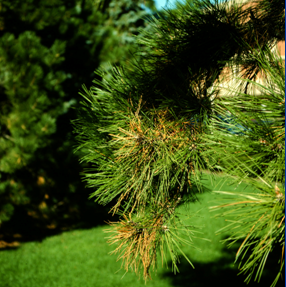
What is Diplodia shoot blight and canker?
Diplodia shoot blight and canker (formerly Sphaeropsis shoot blight and canker) is one of the most common fungal diseases of Austrian pine in Wisconsin. This disease can also affect other pines including red, jack, Scots and mugo pine, as well as other conifers including cedars, cypresses, firs, junipers and spruces.
What does Diplodia shoot blight and canker look like?
Initially, affected branch tips may ooze a large amount of resin. Eventually, these branch tips brown and die, with dead needles on these branches having varying lengths. As the disease progresses, sunken or swollen, discolored areas (called cankers) may form on infected twigs. Diplodia shoot blight and canker can be distinguished from damage from boring insects (where there also may be heavy resin flow) by an absence of any tunneling.
Where does Diplodia shoot blight and canker come from?
Diplodia shoot blight and canker is caused by several fungi in the genus Diplodia. These fungi include Diplodia sapinea (formerly known as Diplodia pinea and Sphaeropsis sapinea), which has historically been cited as the cause of the disease on Austrian pine. However, this fungus is only one of several Diplodia species that can cause problems on this host. Diplodia fungi survive in infected shoots and pinecones where they form small, black fruiting bodies (i.e., reproductive structures) that produce brown-colored spores.
How do I save a tree with Diplodia shoot blight and canker?
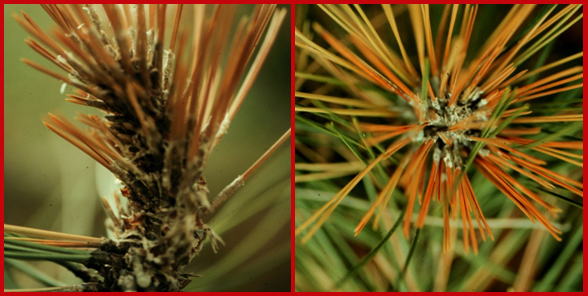
Immediately remove and destroy diseased branch tips. Also, where possible, remove and destroy pinecones that have fallen from infected trees. Dispose of these materials by burning (where allowed by local ordinance) or burying them.
When pruning, cut branches six to eight inches below the point where they are obviously infected. Prune only in dry weather. Between cuts, decontaminate pruning tools by treating them for at least 30 seconds with 70% alcohol (e.g., rubbing alcohol, certain spray disinfectants), or a 10% bleach solution (i.e., one part of a disinfecting bleach and nine parts water). Decontaminating tools is important to help prevent accidental movement of Diplodia fungi from branch to branch during pruning. If you decide to use bleach, be sure to rinse your tools thoroughly after pruning and then oil them to prevent rusting.
How do I avoid problems with Diplodia shoot blight and canker in the future?
Avoid planting Austrian pines; plant other types of evergreens instead. Minimize any stresses on established Austrian pines. Water trees adequately, particularly during dry periods. Established trees should receive approximately one inch of water per week from the time that the ground thaws in the spring, through the summer and into the fall up until the ground freezes or there is a significant snowfall. New transplants (i.e., conifers planted within three years) require approximately two inches of water per week. During periods with insufficient rain, apply water at the drip lines of trees (i.e., the edges of where the branches extend) using a drip or soaker hose.
When planting trees, be sure to allow ample space for roots to grow, avoid compacting the soil around trees, and make sure there is adequate soil drainage. Mulch trees to at least their drip lines with a high-quality mulch (e.g., shredded oak bark mulch, red cedar mulch). Use one to two inches on heavier (e.g., clay) soils. Use three to four inches on lighter (e.g., sandy) soils. Keep mulch approximately four inches from tree trunks. DO NOT fertilize new transplants, and fertilize established conifers only when a soil fertility test indicates that fertilization is needed. DO NOT overfertilize, particularly with nitrogen.
Finally, you may want to apply fungicides to help prevent infections. Apply fungicides only after you have pruned out diseased branches as described above. Fungicides prevent infections but do not cure existing infections. Alternate use of fungicides containing thiophanate-methyl and chlorothalonil that are labeled for use on conifers. Start applications at bud break and continue at 14 day intervals until full shoot elongation. DO NOT use thiophanate-methyl alone. Overuse of thiophanate-methyl can potentially select for variants of Diplodia that will no longer be controlled by this active ingredient. Be sure to read and follow all label instructions of the fungicides that you select to ensure that you use the products in the safest and most effective manner possible.
For more information on Diplodia shoot blight and canker:
Contact the University of Wisconsin Plant Disease Diagnostics Clinic (PDDC) at (608) 262-2863 or pddc@wisc.edu.
Authors: Brian Hudelson, UW-Madison Plant Pathology
Last Revised: 02/29/2024
D-number: D0042
References to pesticide products in this publication are for your convenience and are not an endorsement or criticism of one product over similar products. You are responsible for using pesticides according to the manufacturer’s current label directions. Follow directions exactly to protect the environment and people from pesticide exposure. Failure to do so violates the law.
Thanks to Diana Alfuth, Jean Ferdinandsen, Jason Gough, Phil Luedtke, Scott Reuss and Amy Sausen for reviewing this document.
A complete inventory of UW Plant Disease Facts is available at the University of Wisconsin-Madison Plant Disease Diagnostics Clinic website: https://pddc.wisc.edu.
Send a Plant Sample for Analysis
Be cautious when self-diagnosing plant health issues. Very few diseases can accurately be diagnosed by eye.
Contact the UW Plant Disease Diagnostics Clinic (PDDC), and for a small fee, clinic staff can examine a plant, determine the cause of the disease/disorder, and provide advice on how to control or prevent the issue.
Download Article





 Conifer Disease Quick Reference
Conifer Disease Quick Reference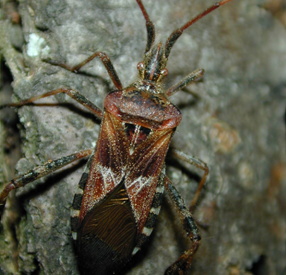 Western Conifer Seed Bug
Western Conifer Seed Bug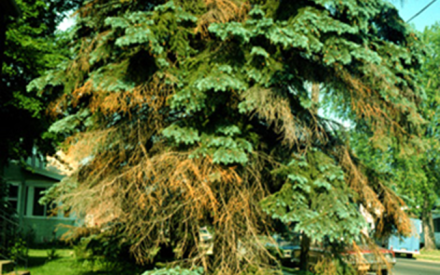 Cytospora Canker
Cytospora Canker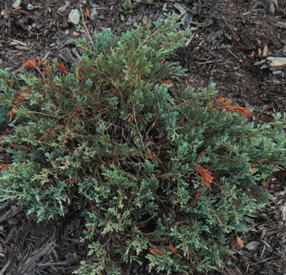 Phomopsis Tip Blight
Phomopsis Tip Blight


